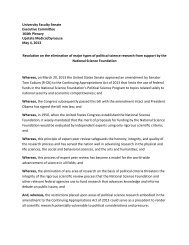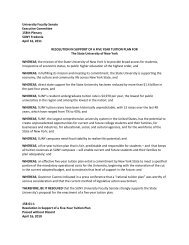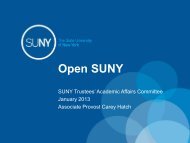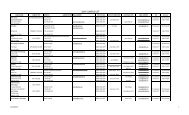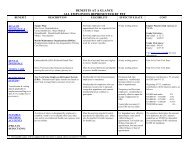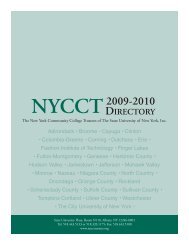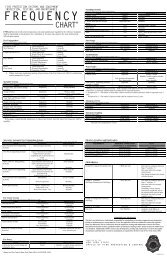Layout 1 copy - The State University of New York
Layout 1 copy - The State University of New York
Layout 1 copy - The State University of New York
Create successful ePaper yourself
Turn your PDF publications into a flip-book with our unique Google optimized e-Paper software.
S P E A K O U T !<br />
Although the soul <strong>of</strong> higher<br />
education, the pursuit <strong>of</strong> knowledge<br />
and understanding, cannot<br />
be discarded, the literal and figurative<br />
doors <strong>of</strong> institutions <strong>of</strong> higher<br />
learning must be thrown open to a<br />
public that yearns to know what<br />
we do and where their money is<br />
being spent. We can no longer<br />
crouch behind intellectual smoke<br />
screens that serve to hide our own<br />
turf battles and mini-power plays.<br />
We cannot pretend outrage when<br />
the legislature acts unilaterally on<br />
issues that we refuse to acknowledge.<br />
We cannot deny that students<br />
have become sophisticated clients<br />
who expect attention to their<br />
needs. Rather, we must acknowledge<br />
the issues that we face while<br />
attempting to connect with the<br />
public that we serve. We must<br />
articulate a potent and positive<br />
argument for higher education.<br />
And, we must generate research<br />
that while not lacking in sophistication,<br />
is readily accessible by a<br />
public that clamors for answers to<br />
questions that directly affect their<br />
lives. I truly believe that if we fail to<br />
reconceptualize our relationship to<br />
the public, our primary stakeholder,<br />
we are committing pr<strong>of</strong>essorial<br />
suicide that will neither be long in<br />
the <strong>of</strong>fering nor pleasant.<br />
Cloistering ourselves into a<br />
small corner while ignoring the<br />
realities that are all to apparent<br />
marginalizes the pr<strong>of</strong>essoriate from<br />
ongoing curricular and philosophical<br />
debates and abandons the<br />
field to those who view education<br />
in terms dramatically different from<br />
us. While there is little the pr<strong>of</strong>essoriate<br />
can do to stem the rising<br />
time <strong>of</strong> economic utilitarianism in<br />
education, we can work diligently<br />
to recover public trust and a place<br />
within discussions over the future<br />
<strong>of</strong> higher education. To become<br />
trusted contributors to the debate,<br />
the pr<strong>of</strong>essoriate must accept<br />
changes in the purpose <strong>of</strong> education;<br />
articulate a rationale for<br />
education that fits comfortably<br />
into the new educational realities,<br />
while also working, from within, to<br />
de-emphasize the enunciation <strong>of</strong><br />
education ideals in terms <strong>of</strong> economic<br />
utility. We must, in essence,<br />
provide services to the community<br />
while also demanding that the<br />
human value <strong>of</strong> education, invaluable<br />
and incalculable, be factored<br />
into the educational equation. If<br />
not, higher education will remain at<br />
risk <strong>of</strong> losing its soul, its purpose,<br />
and perhaps even its life.<br />
SPEAK OUT!<br />
“Emma Lazarus’ ‘Golden<br />
Door’: Thomas Boylston,<br />
Emmerich Kálmán, and<br />
SUNY/China 150 Students<br />
Daniel Marrone<br />
SUNY Distinguished Service<br />
Pr<strong>of</strong>essor and Faculty Senator<br />
Farmingdale <strong>State</strong> College<br />
<strong>The</strong> United <strong>State</strong>s has always<br />
been a safe haven to turn to<br />
for a better life. What should also<br />
be considered is what these immigrants<br />
have given back to our<br />
country. Epic poet Emma Lazarus<br />
(1849-1887) composed <strong>The</strong> <strong>New</strong><br />
Colossus (in 1883) as an “American<br />
welcome” to millions <strong>of</strong> “huddled<br />
masses.” She concludes her epic<br />
work with the promise, “I lift my<br />
lamp beside the golden door!” Her<br />
inspiring words are a credo permanently<br />
affixed at the base <strong>of</strong> the<br />
Statue <strong>of</strong> Liberty in <strong>New</strong> <strong>York</strong> Harbor<br />
as well as in the hearts <strong>of</strong> all<br />
Americans. Written just four years<br />
before her premature death from<br />
cancer, Ms. Lazarus’ American<br />
“golden door” has opened innumerable<br />
times to those in need.<br />
Here are some examples <strong>of</strong> individuals<br />
who came to America and<br />
have “given back” indelible legacies.<br />
Like those before and many,<br />
many since, Thomas Boylston<br />
(1644-1695) immigrated to the<br />
<strong>New</strong> World seeking greater opportunities<br />
for his family. Already an<br />
eminent surgeon in England, he<br />
hoped for more freedom in practicing<br />
his chosen pr<strong>of</strong>ession. After<br />
settling in Boston, Boylston raised<br />
his family. Among his children was<br />
medical pioneer Zabdiel Boyston<br />
(1679-1766) who achieved many<br />
“firsts.” Among his monumental<br />
achievements were the first documented<br />
surgical operations to<br />
remove gallstones (in 1710) and<br />
breast tumors (in 1718). He was<br />
also the first physician to use<br />
inoculations (in 1721) to prevent<br />
smallpox. Through his groundbreaking<br />
medical innovations that<br />
subsequently were to become<br />
standardized medical practices,<br />
Zabdiel Boylston is justly credited<br />
with saving countless lives. Immigrant<br />
Thomas Boyston’s granddaughter,<br />
Abigail Boylston Smith<br />
(1744-1818) married—at the<br />
time—a school teacher who would<br />
soon turn to the law as a new<br />
career. This nascent attorney<br />
became prominent during the<br />
American Revolution serving in<br />
numerous ministerial capacities.<br />
He also was to become our second<br />
president, John Adams (1735-<br />
1826). <strong>The</strong>ir son, John Quincy<br />
Adams (1767-1848), became our<br />
sixth president from 1825 to<br />
1829. After being president, “JQA”<br />
(as he preferred to be addressed)<br />
spent a long, illustrious career in<br />
the U.S. House <strong>of</strong> Representatives<br />
tirelessly fighting for abolition<br />
(Nagel, 1997; Toledo-Pereyra,<br />
2006). <strong>The</strong> Adamses and Boylstons<br />
have continued to be leading figures<br />
in American history.<br />
Emmerich Kálmán entered<br />
Emma’s “golden door” in 1940.<br />
Born Imre Koppstein in Siófok<br />
(formerly in the Austro-Hungarian<br />
Empire) in 1882, Kálmán, along<br />
with Franz Lehár, created the<br />
“Silver Age” <strong>of</strong> Viennese operetta<br />
during the first quarter <strong>of</strong> the 20th<br />
century. Operettas, to an extent,<br />
have served as musical forms<br />
bridging grand operas and today’s<br />
Broadway musicals. In fact, many<br />
<strong>of</strong> Kálmán’s German-language<br />
operettas (such as Gräfin Mariza)<br />
were translated and produced on<br />
Broadway and became long-running<br />
hits! After Austria’s Anschluss with<br />
Germany, Kálmán was forced to<br />
leave Vienna in 1939. He lived<br />
most <strong>of</strong> the remaining 14 years <strong>of</strong><br />
his life in the United <strong>State</strong>s. He<br />
continued to compose while in the<br />
U.S. including collaborations with<br />
Lorenz (“Larry”) Hart. By 1945, in<br />
increasing declining health, Kálmán<br />
wrote his last operetta, Arizona<br />
Lady. Although entirely European<br />
in outlook, Kálmán let it be known<br />
that this final musical work was<br />
his heartfelt tribute to his adopted<br />
country (Martin, 2005, p. 12).<br />
He passed away in 1953 forever<br />
grateful to the U.S. for opening its<br />
“golden door” to him.<br />
In 2008, 150 undergraduate<br />
students from earthquake ravaged<br />
China entered 22 SUNY campuses.<br />
<strong>The</strong>se young men and women are<br />
pursuing their education undeterred<br />
by tragic events at home. <strong>The</strong><br />
Chinese students are now our<br />
students. <strong>The</strong>y are affectionately<br />
referred to as the “SUNY/China<br />
150” group. <strong>The</strong> students have<br />
promised to return to their homeland<br />
after a year <strong>of</strong> study in America<br />
to help rebuild their devastated<br />
Sichuan Province. <strong>The</strong>y will go back<br />
with the knowledge and confidence<br />
to lead the ongoing monumental<br />
reconstruction effort in the Upper<br />
Yangtze Valley <strong>of</strong> southwestern<br />
China. I have been fortunate to be<br />
assigned all 19 <strong>of</strong> these students<br />
attending Farmingdale <strong>State</strong><br />
College. <strong>The</strong>ir participation in my<br />
Business, Government & Society<br />
(BUS412) course has been very<br />
beneficial. Bringing a different<br />
perspective to business-societal<br />
relationships, they have challenged<br />
my thinking regarding the course.<br />
Whether intentional or not, they<br />
have broadened my understanding<br />
<strong>of</strong> the raison d’êtrè <strong>of</strong> the course.<br />
As a result, I hope to refocus and<br />
rename this course, Global Affairs<br />
in Business, Government & Society<br />
in the near future. It is too early to<br />
tell regarding the lasting effect <strong>of</strong><br />
having our China group at SUNY.<br />
However, from what I have experienced<br />
so far, I can truly say these<br />
are wonderful individuals. SUNY has<br />
been given a gift by their presence.<br />
<strong>The</strong>se accounts <strong>of</strong> special individuals<br />
are intended to show that<br />
Emma Lazarus’ “golden door” not<br />
only provides a welcoming entry<br />
into our country. <strong>The</strong> door also<br />
swings the other way by allowing<br />
newcomers to our shores a way<br />
for their goodness and contributions<br />
to come out as well!<br />
References:<br />
Martin, J. W. (2005). A Survey <strong>of</strong><br />
the Operettas <strong>of</strong> Emmerich Kálmán.<br />
Doctoral dissertation, Louisiana <strong>State</strong><br />
<strong>University</strong>, Baton Rouge, LA.<br />
Nagel, P. C. (1997). John Quincy Adams:<br />
A Public Life, A Private Life. Cambridge,<br />
MA: Harvard <strong>University</strong> Press.<br />
Toledo-Pereyra, L. H. (2006). Zabdiel<br />
Boylston: First American Surgeon <strong>of</strong><br />
the English Colonies in North America.<br />
Journal <strong>of</strong> Investigate Surgery 19(1)<br />
5-10. (Dr. Luis H. Toledo-Pereyra is<br />
Pr<strong>of</strong>essor <strong>of</strong> Surgery and Director <strong>of</strong><br />
Research at Michigan <strong>State</strong> <strong>University</strong><br />
Kalamazoo Center for Medical Studies.)<br />
9



